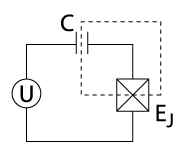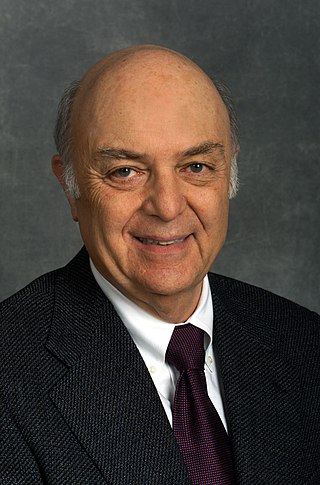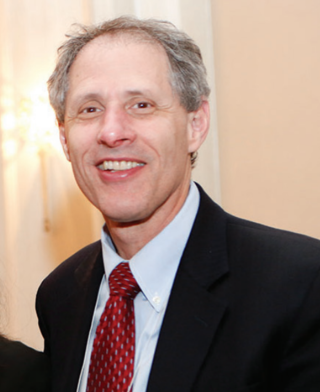Related Research Articles

In quantum computing, a charge qubit is a qubit whose basis states are charge states. In superconducting quantum computing, a charge qubit is formed by a tiny superconducting island coupled by a Josephson junction to a superconducting reservoir. The state of the qubit is determined by the number of Cooper pairs which have tunneled across the junction. In contrast with the charge state of an atomic or molecular ion, the charge states of such an "island" involve a macroscopic number of conduction electrons of the island. The quantum superposition of charge states can be achieved by tuning the gate voltage U that controls the chemical potential of the island. The charge qubit is typically read-out by electrostatically coupling the island to an extremely sensitive electrometer such as the radio-frequency single-electron transistor.

In physics and chemistry, the Nernst effect is a thermoelectric phenomenon observed when a sample allowing electrical conduction is subjected to a magnetic field and a temperature gradient normal (perpendicular) to each other. An electric field will be induced normal to both.

Bismuth strontium calcium copper oxide (BSCCO, pronounced bisko), is a type of cuprate superconductor having the generalized chemical formula Bi2Sr2Can−1CunO2n+4+x, with n = 2 being the most commonly studied compound (though n = 1 and n = 3 have also received significant attention). Discovered as a general class in 1988, BSCCO was the first high-temperature superconductor which did not contain a rare-earth element.

In condensed matter physics, a pseudogap describes a state where the Fermi surface of a material possesses a partial energy gap, for example, a band structure state where the Fermi surface is gapped only at certain points. The term pseudogap was coined by Nevill Mott in 1968 to indicate a minimum in the density of states at the Fermi level, N(EF), resulting from Coulomb repulsion between electrons in the same atom, a band gap in a disordered material or a combination of these. In the modern context pseudogap is a term from the field of high-temperature superconductivity which refers to an energy range (normally near the Fermi level) which has very few states associated with it. This is very similar to a true 'gap', which is an energy range that contains no allowed states. Such gaps open up, for example, when electrons interact with the lattice. The pseudogap phenomenon is observed in a region of the phase diagram generic to cuprate high-temperature superconductors, existing in underdoped specimens at temperatures above the superconducting transition temperature.
Harry L. Swinney is an American physicist noted for his contributions to the field of nonlinear dynamics.

Marvin Lou Cohen is an American theoretical physicist. He is a University Professor of Physics at the University of California, Berkeley. Cohen is a leading expert in the field of Condensed Matter Physics. He is highly cited and most widely known for his seminal work on the electronic structure of solids.
A superinsulator is a material that at low but finite temperatures does not conduct electricity, i.e. has an infinite resistance so that no electric current passes through it.
Patrick A. Lee is a professor of physics at the Massachusetts Institute of Technology (MIT).
Tom Timusk is a Professor Emeritus of Physics at McMaster University in Hamilton, Ontario Canada. He is a retired member of the Condensed Matter research team at McMaster. He was an immigrant from Estonia displaced by Second World War. He settled in Hamilton, Ontario Canada.
Subir Sachdev is Herchel Smith Professor of Physics at Harvard University specializing in condensed matter. He was elected to the U.S. National Academy of Sciences in 2014, and received the Lars Onsager Prize from the American Physical Society and the Dirac Medal from the ICTP in 2018. He was a co-editor of the Annual Review of Condensed Matter Physics from 2017-2019.

Thomas Felix Rosenbaum is an American physicist and the current president of the California Institute of Technology. Earlier he served as Provost and on the faculty of the University of Chicago, and was the Vice President for Research at Argonne National Laboratory.
James (Jim) P. Eisenstein is the Frank J. Roshek Professor of Physics and Applied Physics at the physics department of California Institute of Technology.

Michel Devoret is a French physicist and F. W. Beinecke Professor of Applied Physics at Yale University. He also holds a position as the Director of the Applied Physics Nanofabrication Lab at Yale. He is known for his pioneering work on macroscopic quantum tunneling, and the single-electron pump as well as in groundbreaking contributions to initiating the fields of circuit quantum electrodynamics and quantronics.

Thomas Maurice Rice is an Irish theoretical physicist specializing in condensed matter physics.
Egor Babaev is a Russian-born Swedish physicist. In 2001, he received his PhD in theoretical physics from Uppsala University (Sweden). In 2006 he joined the faculty of the KTH Royal Institute of Technology in Stockholm. In 2007-2013 he shared this position with a faculty appointment at Physics Department of the University of Massachusetts, Amherst (USA). He is currently full professor at the Physics Department KTH Royal Institute of Technology.
Pablo Jarillo-Herrero is a Spanish physicist and current Cecil and Ida Green Professor of Physics at Massachusetts Institute of Technology (MIT).
John F. Mitchell is an American chemist and researcher. He is the Deputy Director of the Materials Science Division at the U.S. Department of Energy’s (DOE) Argonne National Laboratory and leads Argonne's Emerging Materials Group.
Nandini Trivedi is an Indian-American physicist and Professor of Physics at Ohio State University. Her research is on the emergence of new states of matter arising from strong interactions between electrons in quantum materials. She was elected a Fellow of the American Association for the Advancement of Science in 2020.
Bogdan Andrei Bernevig is a Romanian Quantum Condensed Matter Professor of Physics at Princeton University and the recipient of the John Simon Guggenheim Fellowship in 2017.

Alexander Avraamovitch Golubov is a doctor of physical and mathematical sciences, associate professor at the University of Twente (Netherlands). He specializes in condensed matter physics with the focus on theory of electronic transport in superconducting devices. He made key contributions to theory of Josephson effect in novel superconducting materials and hybrid structures, and to theory of multiband superconductivity.
References
- 1 2 3 UIC faculty Juan Carlos Campuzano, University of Illinois at Chicago
- ↑ Argonne Distinguished Fellow, Argonne National Laboratory
- ↑ US Department of Energy
- ↑ Oliver E. Buckley Condensed Matter Prize
- ↑ Argonne National Laboratory
- ↑ "APS Fellow Archive". American Physical Society. (search on year=2001 and institution=University of Illinois, Chicago)